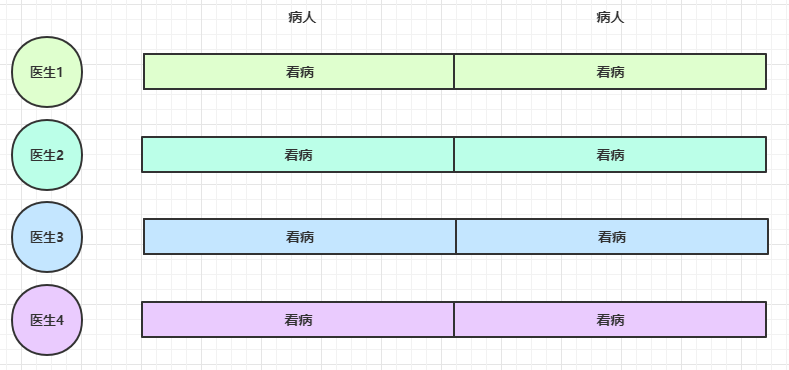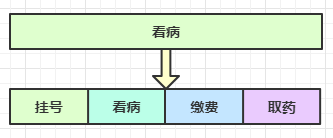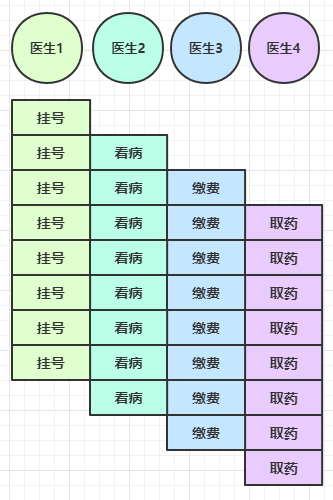目录
一、简介
二、ChannelFuture
三、CloseFuture
四、💡 异步提升的是什么
一、简介
channel 的主要作用
- close() 可以用来关闭 channel
- closeFuture() 用来处理 channel 的关闭
-
- sync 方法作用是同步等待 channel 关闭
- 而 addListener 方法是异步等待 channel 关闭
- pipeline() 方法添加处理器
- write() 方法将数据写入
- writeAndFlush() 方法将数据写入并刷出
二、ChannelFuture
这时刚才的客户端代码
public static void test01(){try {new Bootstrap().group(new NioEventLoopGroup()).channel(NioSocketChannel.class).handler(new ChannelInitializer<Channel>() {@Overrideprotected void initChannel(Channel ch) {ch.pipeline().addLast(new StringEncoder());}}).connect("127.0.0.1", 8080).sync().channel().writeAndFlush(new Date() + ": hello world!");} catch (InterruptedException e) {throw new RuntimeException(e);}}现在把它拆开来看
public static void test02(){ChannelFuture channelFuture = new Bootstrap().group(new NioEventLoopGroup()).channel(NioSocketChannel.class).handler(new ChannelInitializer<Channel>() {@Overrideprotected void initChannel(Channel ch) {ch.pipeline().addLast(new StringEncoder());}}).connect("127.0.0.1", 8080); // 1try {channelFuture.sync().channel().writeAndFlush(new Date() + ": hello world!");} catch (InterruptedException e) {throw new RuntimeException(e);}}- 1 处返回的是 ChannelFuture 对象,它的作用是利用 channel() 方法来获取 Channel 对象
注意:
connect 方法是异步的,意味着不等连接建立,方法执行就返回了。
因此 channelFuture 对象中不能【立刻】获得到正确的 Channel 对象
实验如下:
public static void test03(){ChannelFuture channelFuture = new Bootstrap().group(new NioEventLoopGroup()).channel(NioSocketChannel.class).handler(new ChannelInitializer<Channel>() {@Overrideprotected void initChannel(Channel ch) {ch.pipeline().addLast(new StringEncoder());}}).connect("127.0.0.1", 8080);System.out.println(channelFuture.channel()); // 1try {channelFuture.sync(); // 2} catch (InterruptedException e) {throw new RuntimeException(e);}System.out.println(channelFuture.channel()); // 3}- 执行到 1 时,连接未建立,打印
[id: 0x2e1884dd] - 执行到 2 时,sync 方法是同步等待连接建立完成
- 执行到 3 时,连接肯定建立了,打印 [id: 0xd3e8b042, L:/127.0.0.1:62083 - R:/127.0.0.1:8080]
除了用 sync 方法可以让异步操作同步以外,还可以使用回调的方式:
public static void test04() {ChannelFuture channelFuture = new Bootstrap().group(new NioEventLoopGroup()).channel(NioSocketChannel.class).handler(new ChannelInitializer<Channel>() {@Overrideprotected void initChannel(Channel ch) {ch.pipeline().addLast(new StringEncoder());}}).connect("127.0.0.1", 8080);System.out.println(channelFuture.channel()); // 1channelFuture.addListener((ChannelFutureListener) future -> {System.out.println(future.channel()); // 2});}- 执行到 1 时,连接未建立,打印 [id: 0xe72025cf]
- ChannelFutureListener 会在连接建立时被调用(其中 operationComplete 方法),因此执行到 2 时,连
接肯定建立了,打印 [id: 0xe72025cf, L:/127.0.0.1:62263 - R:/127.0.0.1:8080]
三、CloseFuture
@Slf4j
public class CloseFutureClient {public static void main(String[] args) throws InterruptedException {NioEventLoopGroup group new NioEventLoopGroup();ChannelFuture channelFuture = new Bootstrap().group(group).channel(NioSocketChannel.class).handler(new ChannelInitializer<NioSocketChannel>() {@Override // 在连接建立后被调用protected void initChannel(NioSocketChannel ch) throws Exception {ch.pipeline().addLast(new LoggingHandler(LogLevel.DEBUG));ch.pipeline().addLast(new StringEncoder());}}).connect(new InetSocketAddress("localhost", 8080));Channel channel = channelFuture.sync().channel();log.debug("{}", channel);new Thread(()->{Scanner scanner = new Scanner(System.in);while (true) {String line = scanner.nextLine();if ("q".equals(line)) {channel.close(); // close 异步操作 1s 之后
// log.debug("处理关闭之后的操作"); // 不能在这里善后break;}channel.writeAndFlush(line);}}, "input").start();// 获取 CloseFuture 对象, 1) 同步处理关闭, 2) 异步处理关闭ChannelFuture closeFuture = channel.closeFuture();/*log.debug("waiting close...");closeFuture.sync();log.debug("处理关闭之后的操作");*/closeFuture.addListener(new ChannelFutureListener() {@Overridepublic void operationComplete(ChannelFuture future) throws Exception {log.debug("处理关闭之后的操作");group.shutdownGracefully();}});}
}四、💡 异步提升的是什么
- 有些同学看到这里会有疑问:为什么不在一个线程中去执行建立连接、去执行关闭 channel,那样不是也可以
吗?非要用这么复杂的异步方式:比如一个线程发起建立连接,另一个线程去真正建立连接
- 还有同学会笼统地回答,因为 netty 异步方式用了多线程、多线程就效率高。
其实这些认识都比较片面,多线程和异步所提升的效率并不是所认为的
思考下面的场景,4 个医生给人看病,每个病人花费 20 分钟,而且医生看病的过程中是以病人为单位的,一个病
人看完了,才能看下一个病人。假设病人源源不断地来,可以计算一下 4 个医生一天工作 8 小时,处理的病人总
数是:4 * 8 * 3 = 96

经研究发现,看病可以细分为四个步骤,经拆分后每个步骤需要 5 分钟,如下

因此可以做如下优化,只有一开始,医生 2、3、4 分别要等待 5、10、15 分钟才能执行工作,但只要后续病人源
源不断地来,他们就能够满负荷工作,并且处理病人的能力提高到了 4 * 8 * 12 效率几乎是原来的四倍

要点
- 单线程没法异步提高效率,必须配合多线程、多核 cpu 才能发挥异步的优势
- 异步并没有缩短响应时间,反而有所增加
- 合理进行任务拆分,也是利用异步的关键


















